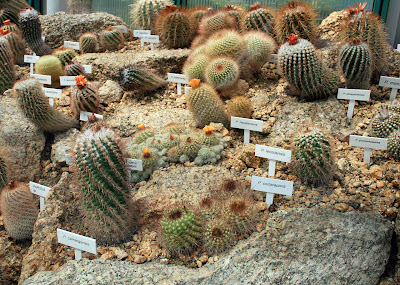Cacti are odd plants -- they lack leaves, photosynthesis takes place in their fat green stems, and most are covered with pain-inducing spines. Yet they are charismatic. We find their unusual forms striking, beautiful, even enchanting.
 |
Echinopsis mamillosa, an easter lily or sea urchin cactus of Bolivia. Photo by Stan Shebs.
|
 |
Various species of Parodia cacti (South America). Photo by Karelj.
|
 |
“In a Sahuaro forest, Arizona” Lollesgard Specialty Co., Tucson. Published 1936.
|
Their vicious spines are lovely too -- arranged as they are in such elegant patterns.
 |
| Spines of Echinocereus viridiflorus, a hedgehog cactus. |
 |
| Coryphantha vivipara, a pincushion cactus. This one is recovering from a fire. |
 |
| Buffalo bur is a member of the Nightshade Family, like tomato, potato and eggplant. Photo by Joseph Marcus, Lady Bird Johnson Wildflower Center. |
Only in the cactus family (Cactaceae) are spines arranged in clusters. These develop in leaf axils -- where the leaves join the stem. But wait -- cacti don’t have leaves! It turns out they do, but most are tiny and soon fall off.
 |
| Clusters of spines on a prickly pear cactus pad (Opuntia sp.). |
The spines themselves often are referred to as highly-modified leaves, but we still aren’t sure. There are two interpretations as to how spines developed evolutionarily. They may be highly-modified leaves on specialized condensed shoots (side branches), or they may be modified bud scales (also modified leaves, which cover an embryonic shoot).
At maturity, spines and leaves are very different. Spines have none of the usual leaf features, like blades, veins, stomates and photosynthetic tissue. Instead, they contain fibers and thickened, almost woody epidermal tissue, neither of which is found in leaves. Thus different sets of genes are utilized during development. Finally, spines are basically dead, while leaves are composed of living tissue. So why call spines modified leaves? ... because both develop from the same type of embryonic structures -- leaf primordia. Bud scales come from these primordia too, hence the confusion. See Mauseth 1976 and 2006 for more details and discussion.
 |
| Prickly pear spine clusters: large spines radiate outwards, pale-colored glochids form clusters at base (click photo for closer view). |

Members of the prickly pear subfamily (Opuntioideae) have two types of spines -- the normal type we’re used to seeing, and insidious hair-like little buggers called glochids. The larger ones generally stay put when bumped, but glochids come off easily. They can burrow into the skin, are hard to find, and sometimes seem impossible to remove. Chart courtesy REI (click to view).
Spines develop on structures called areoles. Wikipedia explains that these are “highly specialized branches on cacti ... apparently they evolved as abortive branch buds while their spines evolved as vestigial leaves.” “apparently” is the proper adverb in this case; as with spines, more work needs to be done to understand the evolutionary path to areoles. Above and below: a pincushion cactus (Coryphantha vivipara) post-burn on Sheep Mountain, southeast Wyoming. In the recovering plant, green tubercules are visible, with clusters of spines growing from the areoles on top.
Left: Mammillaria bombycina, by Brian Johnson (Micscape); used with permission. Spines are clustered on areoles at the top of tubercules. For more stunning photos and photomicrographs of cacti, see Brian’s A Close-up View of Several Members of the Cactus Family. Even if technical details of cactus anatomy are not your thing, this site is still well worth visiting -- for the incredible beauty of the portraits.
Areoles also are where cactus flowers develop -- those beautiful, colorful blooms that contrast so strikingly with the dull green plants.
What's that bright red patch in the piñon - juniper woodland? (San Rafael Swell, Colorado)
It's that show-off prima donna -- claret cup cactus (Echinocereus triglochidiatus).
Areoles commonly occur on tubercules, but they also may be arranged along ribs, as in Echinocereus viridiflorus, the hedgehog cactus below.

Along with spines, this "old man cactus" has "whiskers" -- hairs said to have evolved to shade the stem and reduce water loss. But who knows? Maybe they really evolved to appeal to people -- who take them in and care for them ;-)
Sources (in addition to links in post)
Websites:
CactiGide.com is a handy reference site for cacti.
James D. Mauseth’s research site (cacti): http://www.sbs.utexas.edu/mauseth/researchoncacti/index.htm
Dalhousie Collection of Cacti & Other Succulents at Dalhousie University http://cactus.biology.dal.ca/index.html
Literature:
Mauseth, J.D. 1976. Cytokinin- and gibberellic acid-induced effects on the structure and metabolism of shoot apical meristems in Opuntia polyacantha (Cactaceae). American Journal of Botany 63: 1295-1301.
Mauseth, J.D. 2006. Structure-function relationships in highly modified shoots of Cactaceae. Invited review. Annals of Botany 98: 901–926.








Your description of the glochids as "hair-like little buggers" is much kinder than the little (
ReplyDelete*^%!D%^^&^!! deserve. You are a model of botanical restraint.
Thanks for visiting! yeah, they are nasty, I agree.
Delete